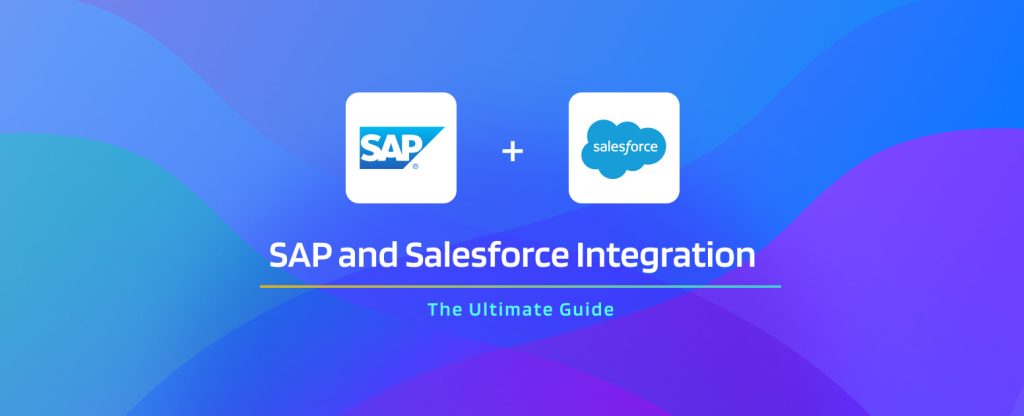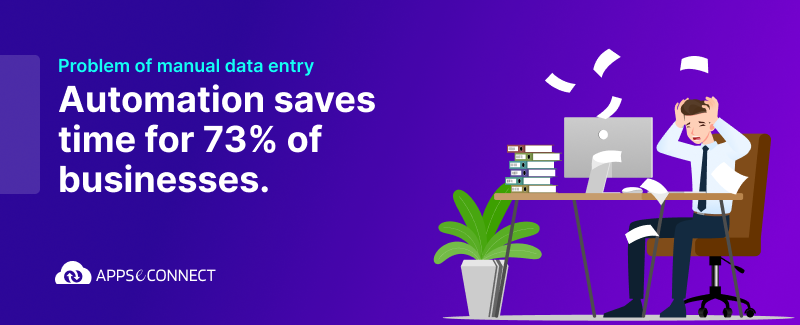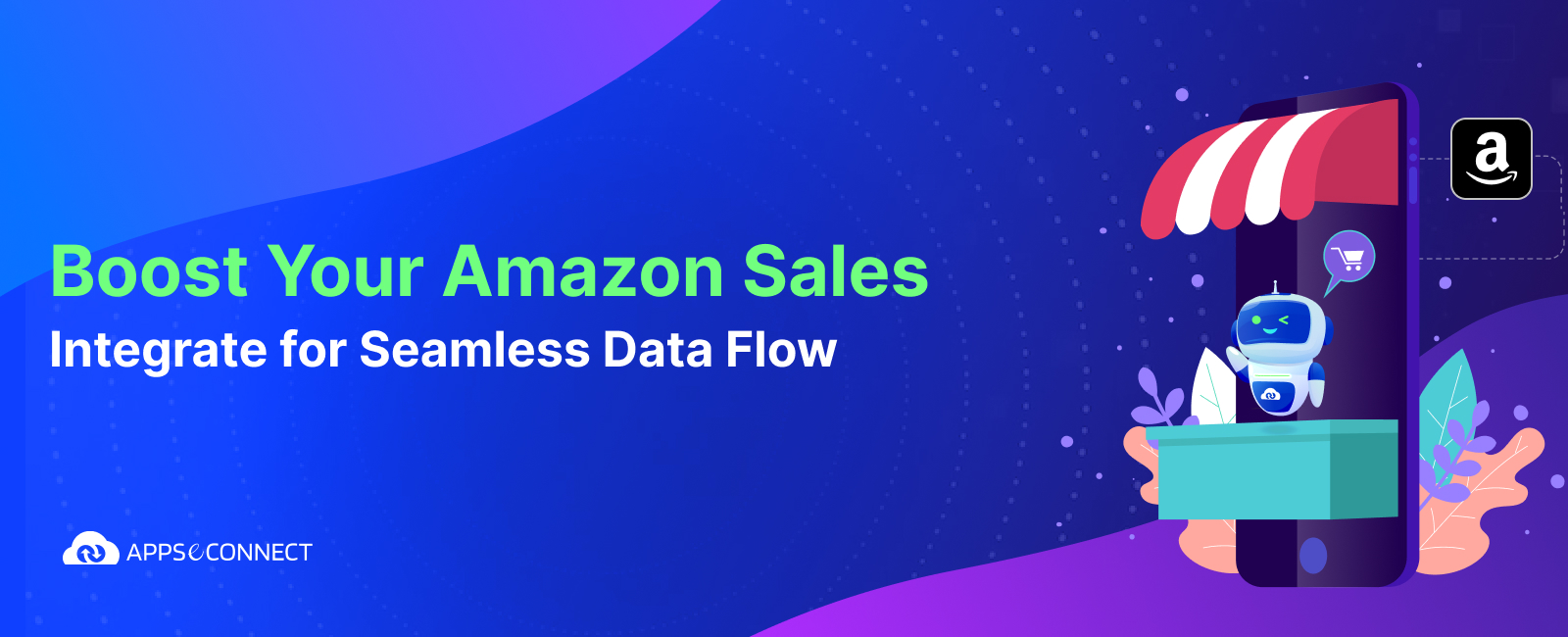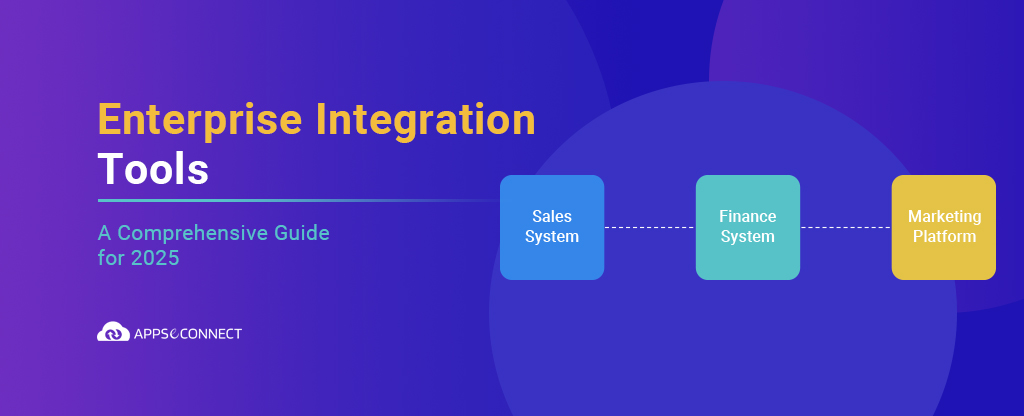Enterprises are increasingly adopting best-of-breed solutions for their respective business functions. It is common to see companies implementing MS Teams / Slack for internal collaboration, Workday for HRMS and Salesforce for their marketing, sales and customer support functions. SAP remains an undisputed leader in the enterprise resource planning (ERP) category. While using the best-of-the-breed solutions, it becomes imperative to integrate the applications so that information exchange is streamlined. Hence when it comes to integrating ERP and CRM applications for a mid to large-sized company, we are often talking about SAP Salesforce integration. Such Salesforce SAP integration helps empower the customer-facing roles with the powerhouse that SAP itself is. Information regarding product launches, price changes, customers and much more can be exchanged so that there is only a single version of the truth.
Why do Businesses Need SAP and Salesforce Integration
Delivering an effective and engaging customer experience plays a key role in ensuring customer loyalty and retention. Integrating your backend ERP with your CRM system allows customer-facing teams to directly access actionable customer data and communicate with them more effectively. With the complexity and volume of data processed by SAP ERPs and Salesforce for their respective operations, it is prudent to maintain seamless data exchange between the platforms to ensure streamlined business workflows. These are the day-to-day examples that highlight the importance of such an integration.
- Quote Accuracy – Tanya is creating a quotation within Salesforce for ABC Corp, one of their big distributors. However, she is not sure whether the price reflected in the platform is the exact customer-specific price for ABC. She knows that being a large customer some price updates were done within SAP. Also, previously she added a discontinued product model to the quote since it was still active within Salesforce. She doesn’t want to repeat the mistake this time.The key learning is that SAP’s master data and pricing information play an important base for the Sales team to transact with confidence on Salesforce.
- Account Receivable – Ryan is a sales rep working for a company dealing in industrial parts. Outstanding payments have been one of the top concerns for the top management. Ryan has been asked by his regional manager to follow up on invoices pending payment during the customer visits. He doesn’t have visibility of the Account statement from SAP and is unsure of recent payments made by the customer. He usually coordinates with Sarah, the AR clerk to get the updated information.Having real-time visibility without depending on offline coordination is a key to an efficient order to cash cycle as well as productivity.
- Service Installation and Warranty Information – Best Coffee Inc, install coffee vending machines for corporates and offer a 2-year warranty on service and labor. Nate is a customer service representative who works on responding to customer complaints. Nate doesn’t know the warranty terms defined in SAP and needs to check by logging into SAP to get relevant details. After punching in a service request, he needs to create a notification and work orders. Nate’s service engineering team put in a timesheet which then feeds into the Service order for billing to the end customer.By having an installed base within Salesforce, customer service reps can do a much better job. They can search based on serial numbers, check warranty terms and engage with customer support requests in a far more efficient manner.
- Promotions and Discounts – A merchandise distribution company runs Thanksgiving deals 1 week before the holidays. Prices in SAP are set to change automatically on this date. Mike handles B2B Channel sales within Salesforce.Scheduled events change business data. Having an SAP Salesforce Connector can sync these changes with the other application.
- Customer Acquisition and Onboarding – Sam has registered a new customer in Salesforce and the customer is ready to place an order with the company. However, the customer needs a master data record to be created in SAP along with the setting up of credit limits and payment terms. Sam knows that the onboarding process itself may take a few days of follow-up with the accounting team and he may lose the customer in this period.Having a connector synchronize customer master in a bi-directional fashion quickens the process of syncing the records as well as sending the updates as soon as the information is updated in the source system.
If you are using multiple business applications to manage your organization and want to seamlessly do SFDC SAP integration through a single platform to automate and streamline your business processes, then employ APPSeCONNECT’s Integration and achieve a new level of improvement to your business metrics.

SAP Editions – Impact on the SAP Integration Process
Based on the industry vertical, enterprise size, and functional role, both SAP and Salesforce offer their customers a wide range of solutions. You might be surprised at the number of editions and technologies/offerings both Salesforce and SAP provide. However, for now, we will be focusing only on the SAP ERPs and what they mean.
- SAP S/4/ Hana – This is undoubtedly the future for all enterprise customers using SAP. It comes with a lot of configurable features using which you can define Sales, Logistics, Finance and Human Capital Management functions. It runs on a powerful HANA database which is that of SAP proprietary technology. S4 can be hosted on-premise, on a private cloud, or can also be used as a service. S4 has a complex technology stack including Fiori, ABAP and HANA database.S4 Supports OData, RFC and IDOC protocols. They can be mixed and matched to support integration with Salesforce. It may be noted that some editions of S4 may not support all these mentioned protocols. Hence, check with your SAP partner to see which would be the best way to execute the project.
- SAP ECC / All in One – It is an older version of S4 and the majority of SAP’s enterprise, this is being widely used by companies across the globe. However, it is being upgraded to S4 in many instances. SAP claims that it will support ECC till 2027. This version is based on the ABAP cum NetWeaver stack and works on top to support multiple databases. The integration option for SAP ECC with Salesforce is similar to S4. Most of the ECC deployments are on-premise and it is best to use a Hybrid connector in this case.
- SAP Business One – This mid-segment offering from SAP, runs on the Microsoft technology stack. It is built on .NET and runs on MS SQL or HANA databases. SAP Business One can integrate using DI Server or Service layer. The latter is a web-based technology and is widely preferred for cloud-based integration. It may be worth checking which of these are installed on your SAP server so that you can start using the same.
- SAP ByD or Business ByDesign – Business ByDesign is small and mid-segment SaaS-based offering from SAP. It is a hosted solution that provides templates for businesses to define and execute their processes. This platform supports SOAP API and supports various methods out of the box.
Top Considerations for Salesforce integration with SAP
SAP and Salesforce are not only fundamentally different in their technical architecture but also distinct in terms of their philosophy and the business function they support. The former is supposed to be the financial & operation backbone of the organization, latter is meant to be an agile CRM platform that can be deployed and implemented quickly for customer-facing teams. Let us look at what is recommended when it comes to making SAP and Salesforce work in tandem.
Leverage Low Code / No code SFDC SAP integration platform
Look for an integration expert / low code platform and not engage internal resources if not experienced. Integration with Salesforce can be done in several ways, there are many learnings along the way.
Pre-built / Pre-packaged SAP Salesforce connector
Having a time-tested standard template helps. It can reduce the load on your SAP and Salesforce teams. It also accelerates your deployment and helps use the solution. If you have a specific go-to-market timeline in mind and your internal IT team is occupied with other initiatives, it is better to use a solution that comes with a ready template.
Avoid integration overload on SAP Infrastructure
SAP is the enterprise backbone and can do a lot of heavy lifting. However, remember that integration with Salesforce is just one of the crucial processes. While designing the integration, the middleware must take substantial processing and ensure that the load on SAP is not intense.
Maximize standard objects in the applications
Putting a lot of Z objects in SAP, though unavoidable must be controlled. The same goes for Salesforce. Custom objects, validation rules and automation must be checked. Standard integration objects must be leveraged to the maximum.
Optimum Resource Utilization
Salesforce is a SaaS application. This is the key reason why we have governor limits within Salesforce. While integrating we need to maximize our throughput with each API call. They define the permissible threshold values of resource utilization for a specific customer. By defining these policies Salesforce ensures that other customers are not impacted due to excessive by one customer. Some of the limits are related to Data / File Storage, Custom Objects, Apex triggers and the rate of API call consumed.
Are you ready to try our
APPSeCONNECT’s Popular SAP Salesforce Connectors
Salesforce to SAP integration is a necessity for enterprises implementing them. However, most enterprises will not have the resources and team composition to build the Salesforce and SAP integration between the application from scratch. Moreover, enterprises that do have the funds and expertise to do so are diverting valuable resources toward a complex, time-consuming process.
APPSeCONNECT provides a vast suite of intelligent ready-to-use connectors for SAP ERP and Salesforce integration. The following section highlights some of the major functionalities provided by the connectors. Relevant page links are available for you to explore the solution in depth.
Salesforce SAP HANA integration / ECC integration / SAP All in One
APPSeCONNECT integrates master data including customers and material between applications. Changes to these are automatically synchronized with the CRM platform and vice versa. The sales reps can create accurate quotations, and view Sales orders, delivery and invoices seamlessly on the CRM platform even though order fulfillment remains with S4 HANA. Explore the solution in detail.
Salesforce SAP Business One integration
The solution helps empower Sales reps with information on Business partners, prices, and products. They can create Quotations within Salesforce and view the Sales Order, Delivery and Invoice information from SAP. The solution can also be extended to see incoming payments from customers and the after-sales process. Explore the solution in detail.
If you are running on any other SAP Version, please contact us so that we can evaluate the feasibility of integrating the solution.
APPSeCONNECT – The Best-in-Class SAP and Salesforce Connector
APPSeCONNECT is a modern and intelligent integration and business process automation platform that helps organizations streamline their application ecosystem under one roof and provides secure process management for their entire business app stack. The solution provides flexibility in terms of deployment models and mapping business rules. APPSeCONNECT is helping over a thousand customers fulfill their digital transformation initiative by connecting their business applications. Some of the salient features of APPSeCONNECT include.
Low Code platform for application integration.
APPSeCONNECT provides a simplified means of integration for applications like SAP, Salesforce, Amazon, Microsoft Dynamics 365 Business Central, Shopify, WooCommerce, and more. It is developed and hosted on Microsoft Azure.
Cloud and Hybrid deployment models
APPSeCONNECT provides both cloud-based integration offerings where the entire solution is offered as a service. Hybrid deployments are done when customers have an obligation or regulatory constraint to retain business data on their premise. Under this option, integration rules are defined in the cloud. However, the actual data exchange happens within the client’s own infrastructure.
Accelerated end-to-end integration solutions
The platform provides end-to-end solution templates for popular line-of-business applications. By taking out the complexity of integration, the application enables businesses to grow by maximizing their presence on popular marketplaces as well as streamlining their internal operations.
Jumpstart your journey towards perpetual scalable success, with the power of APPSeCONNECT.
Integrating SAP and Salesforce using APPSeCONNECT
APPSeCONNECT provides comprehensive integration between SAP and Salesforce CRM. Whether you are using SAP Business One, ECC, Business ByDesign or S/4 HANA as your SAP edition, APPSeCONNECT can accelerate your Salesforce integration journey. In this section, we will describe how we execute our integration projects. After going through the information, you may be able to draw comparison vis-à-vis executing the integration as a custom project.
Sign-up & Onboarding
Once you have created an APPSeCONNECT cloud account, you can choose which SAP version your organization is running on. For instance, you can choose S4 HANA, ECC, SAP Business One with DI Service, SAP Business One with Service Layer or SAP Business ByDesign. You will need to select Salesforce as your other application.
It may be noted that you can create another connection let’s say between SAP and Amazon Seller Central. Hence you can have multiple integrations running within the same APPSeCONNECT account. At this point in time, you can also choose between the cloud or hybrid deployment models.
Click and deploy ready integration templates
The base solution can be deployed with a click of a button. Packages for Salesforce and SAP are deployed to add the custom components to enable the respective communication with the APPSeCONNECT.
Enable / Disable respective sync process
Every business runs in a unique fashion. Though we provide a generic solution, some of the integration points may not be required by you. For example, you may not want the sales rep to create new customers within Salesforce. In this case, business partner sync works from SAP to Salesforce only and the integration in other direction can be disabled.
Field mapping and additional touchpoints
Features that are not in the base solution can be easily tweaked as per specific business needs. Additional field mappings and business rule enforces can also be configured. This process can be done by customers themselves. If you prefer this can be done by an APPSeCONNECT implementation partner or by an onboarding team at APPSeCONNECT as well.
Are you ready to try our
Technical deep dive into APPSeCONNECT’s SAP Salesforce Integration
This section highlights the technical settings which need to be done along with the above steps.
Setting up a connected APP on Salesforce
Creating a connected App helps APPSeCONNECT to exchange information using OAuth. For doing this you need to login into Salesforce as an administrator and go to Create->Apps->Connected Apps.
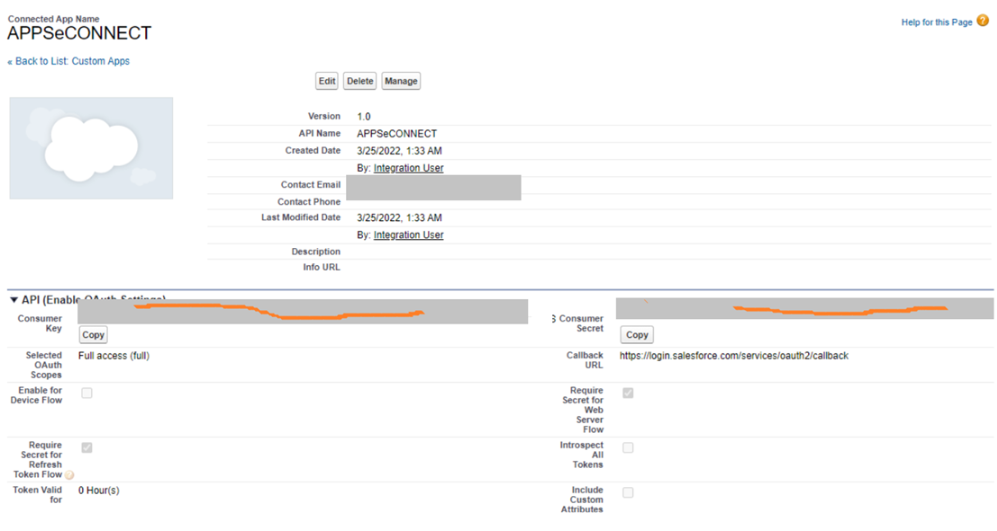
Validate the credentials on the APPSeCONNECT agent
APPSeCONNECT agent needs to seamlessly exchange information with Salesforce. Take note of the consumer key and consumer secret created above and enter the credentials below. When the validation button is clicked, Agent would be able to connect with Salesforce. You would see a success message and you are all set on Salesforce connectivity.
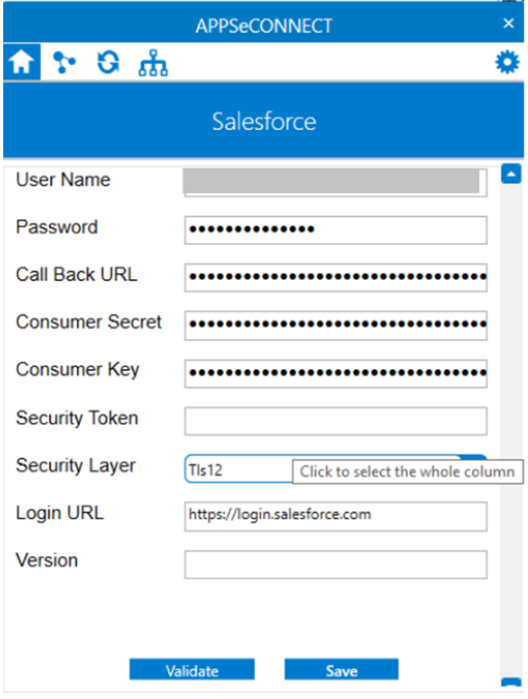
Setting up a connection with SAP
Similar to the connection with Salesforce, we need to enable APPSeCONNECT to connect with SAP. As you might have guessed it, this step will have different for different versions of SAP.
- SAP S4 HANA / ECC Credential Validation – For the application to connect with these versions of SAP, you would need to enter an SAP User with RFC privileges apart from the application server, system number ID and instance number.
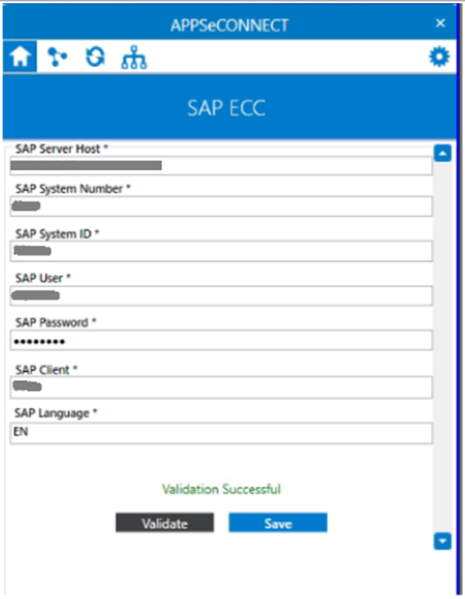
Since APPSeCONNECT also leverages IDOCs, you need to set it up as a logical system within the application and set up a partner profile.
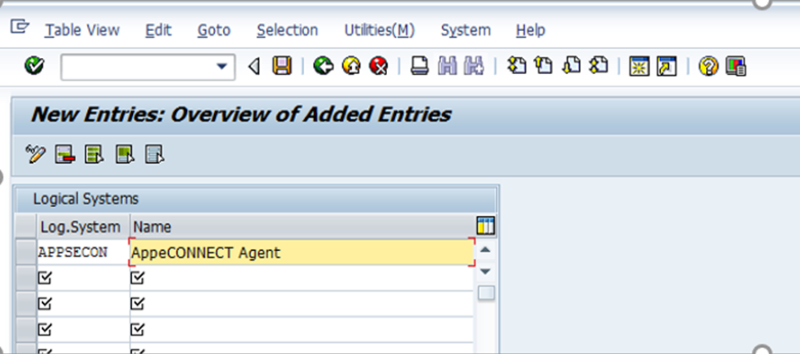
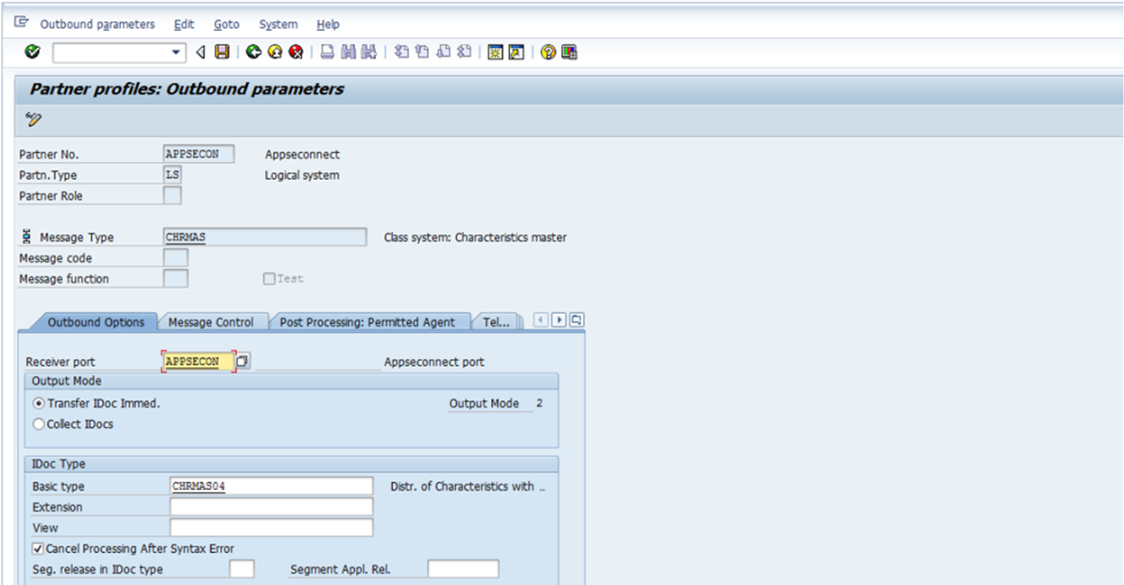
- SAP Business One – Connection with SAP Business One is handled depending on whether the deployment has DI Server or HANA Service layer. In the example below, the credential validation for deployment with the HANA service layer has been shown.
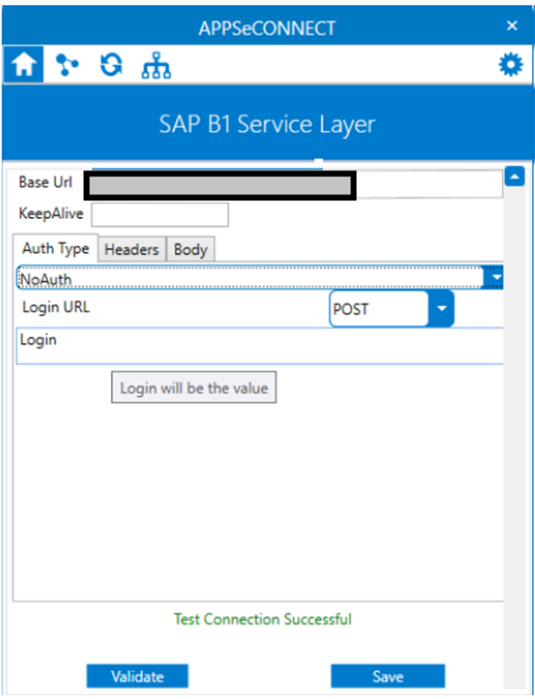
Deployment of platform-specific custom add-on
The out-of-the-box integration between SAP and Salesforce works with some custom add-ons to these platforms.
- Salesforce add-on deployment consists of our time-tested custom objects like Customer Addresses, Invoices, Payments, etc. It also contains process flows that can be deployed and tested in your sandbox environment.
- SAP Export deployment involves importing a package into your sandbox environment, the packages contain custom BAPIs which enable the standard touchpoint. SAP Export deployment contains importing a package in your sandbox/testing environment, the packages contain custom BAPIs which enable the standard touchpoint.
- SAP Business One package consists of custom UDFs and database triggers which are required for the integration to work.
Key Learnings for SAP Salesforce Integration
We have had a fair share of experience while working on the platforms. The following provides a summary of things that can easily be the difference between success and failure.
Packaged offering versus custom integration
One decision point is whether to go for custom integration or an off-the-shelve integration offering. We would recommend going through the feature list of standard features of such integration and deciding whether it meets most of your business needs. If not, custom integration may be the way forward.
Flexibility and evolution of the solution
Going for a pre-configured connector doesn’t mean that you need to sacrifice your remaining needs. The solution will evolve once you start using the platforms. You may collect additional business scenarios and feedback. At this point in time, you may want to enable additional integration points or put in additional field mappings. The solution must be flexible so that these can be accommodated.
Longevity of the solution
Both SAP and Salesforce have their planned releases. It may be worth considering using a platform that can support these releases and keeps your integration intact.
Frequently Asked Questions On SAP Salesforce Integration
The outline questions both from technical and business viewpoints.
Through SAP Salesforce integration, organizations can leverage the vast volume of critical business data generated by their enterprise for analytics and actionable insights to propagate a focused, data-driven workflow across their entire organization. However, building an in-depth integration between the two applications is a time and resource-intensive project even for bigger enterprises to commit to. The necessity for SAP Salesforce integration that can be implemented rapidly with minimal use of resources mandates the need for a smart, low code integration platform. APPSeCONNECT, a next-generation, intelligent integration and business process automation solution offers robust, time-tested connectors for SAP and Salesforce integration. With this integration users can rapidly deploy all the required integration effortlessly and improve their time to market. Jumpstart your journey towards perpetual scalable success, with the power of APPSeCONNECT.


